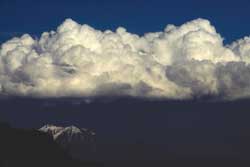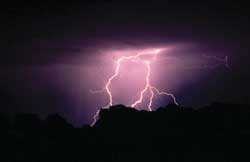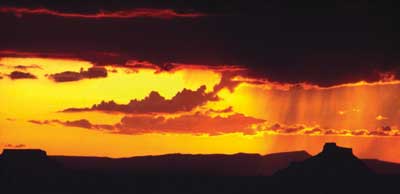 The
past several days have been a tease of parading cumulus
clouds - unfulfilled promises of precipitation that
floated away to points east. Their presence may indicate
fair weather, but, here in August, they seem to foretell
the future – rain. The
past several days have been a tease of parading cumulus
clouds - unfulfilled promises of precipitation that
floated away to points east. Their presence may indicate
fair weather, but, here in August, they seem to foretell
the future – rain.
After a clear sunrise sky, by early afternoon there is
a build-up of whipped cumulonimbus atop the La Sal Mountains.
Darkened undersides indicate the possibility of rain,
long overdue and ever welcomed. Today’s prediction
of afternoon showers looks like a good bet and as soon
as the thunder echoes off of the mountain peaks and rings
in the season of summer thunderstorms, the wait is on.
Rising faster than the head of a Dead Horse Ale, these
clouds achieve the stature of small eastern states, and
they pack a lot more punch than a 3.2 microbrew. Derived
from the Latin word kumelos meaning “a heap” or “a
swelling” and nimbus meaning “violent rain,” these
towering masses form aerial landscapes.
My fondness for these storms has taken a more long-distance
appreciation. I’ve been caught out too many times,
with bolts of fiery lightning striking all around me.
I’ve sat hunched in downpours trying to make myself
smaller than the shrubs around me, hoping that this day
is not the day.
Though I give these thunderstorms the respect they deserve,
I love this time of year. As the mercury rises, heated
air masses rise and start to form pillows of white. A
cloud’s base may form at 14,000 feet, but many
form at lower altitudes. As this leaden air climbs, it
cools and starts to condense. Minute water droplets are
in constant motion within the cloud, but because of their
light weight gravity has little pull on them. Air currents
keep the droplets afloat until they crash into each other
and coalesce into droplets greater than 1/125 of an inch.
Then it’s bombs away!
 In
addition to the precipitation, lightning discharges
within and from the clouds. Electrical charges
generated within the cloud or from the ground
seek out their opposites – negative to
positive and vice versa. When the electrical
pressure is great enough, the charges are released.
A “leader” stroke may originate
from the cloud, followed by a heavier return
stroke from the ground. When I see the lightning,
I start to count “1001, 1002, 1003,” until
I hear Thor’s hammer: the tremendous
heat generated creates a shock or compression
wave called thunder. A 5-second difference
equals about one mile. Sometimes you might
feel the temperature drop as cold air flows
down and out from the thunderhead. This cold
air may travel ahead of the storm by several
miles, allowing sufficient time to seek shelter. In
addition to the precipitation, lightning discharges
within and from the clouds. Electrical charges
generated within the cloud or from the ground
seek out their opposites – negative to
positive and vice versa. When the electrical
pressure is great enough, the charges are released.
A “leader” stroke may originate
from the cloud, followed by a heavier return
stroke from the ground. When I see the lightning,
I start to count “1001, 1002, 1003,” until
I hear Thor’s hammer: the tremendous
heat generated creates a shock or compression
wave called thunder. A 5-second difference
equals about one mile. Sometimes you might
feel the temperature drop as cold air flows
down and out from the thunderhead. This cold
air may travel ahead of the storm by several
miles, allowing sufficient time to seek shelter.
Lightning strikes the Earth an estimated 30 million times
a year (whose job is it to count!). Some people figure
they have a better chance of winning a Powerball lottery
than being struck by lightning. Unless you’re Roy
Sullivan who holds the Guiness World Record for being
struck 7 times in 35 years! You’d think the guy
would make a better choice when dealing with 30 million
volts of electricity.
 Sometimes
these storms break out of a precipitation slump
and let lose a deluge that might last only
twenty minutes, but ends up as a rumbling,
gnashing flash flood barreling down a canyon. Sometimes
these storms break out of a precipitation slump
and let lose a deluge that might last only
twenty minutes, but ends up as a rumbling,
gnashing flash flood barreling down a canyon.
In a land where the upper portion of the soil saturates
very quickly or is impenetrable sandstone to start with,
runoff tends to accumulate fast. Waterfalls appear, as
if by magic, cascading over the slickrock or dry washes
soon become torrents.
Not all flash floods are monsters with foaming jaws gnashing
away on cottonwood trees and unfortunate livestock, but
I’ve hiked in deep narrow slot canyons that have
massive tree trunks wedged fifty feet above me. I’ve
heard of vehicles being swept away while trying to cross
a raging flood (not mine!) and I’ve experienced
the Green River rising unexpectedly from a storm miles
upstream, and had to suffer the consequences of an untethered
boat.
Even though these August storms may be destructive, the
desert usually needs the rain by August. Soaked sagebrush
never smells sweeter and those flash floods may leave
behind a good story. Just be aware and be safe and enjoy
the show!

|